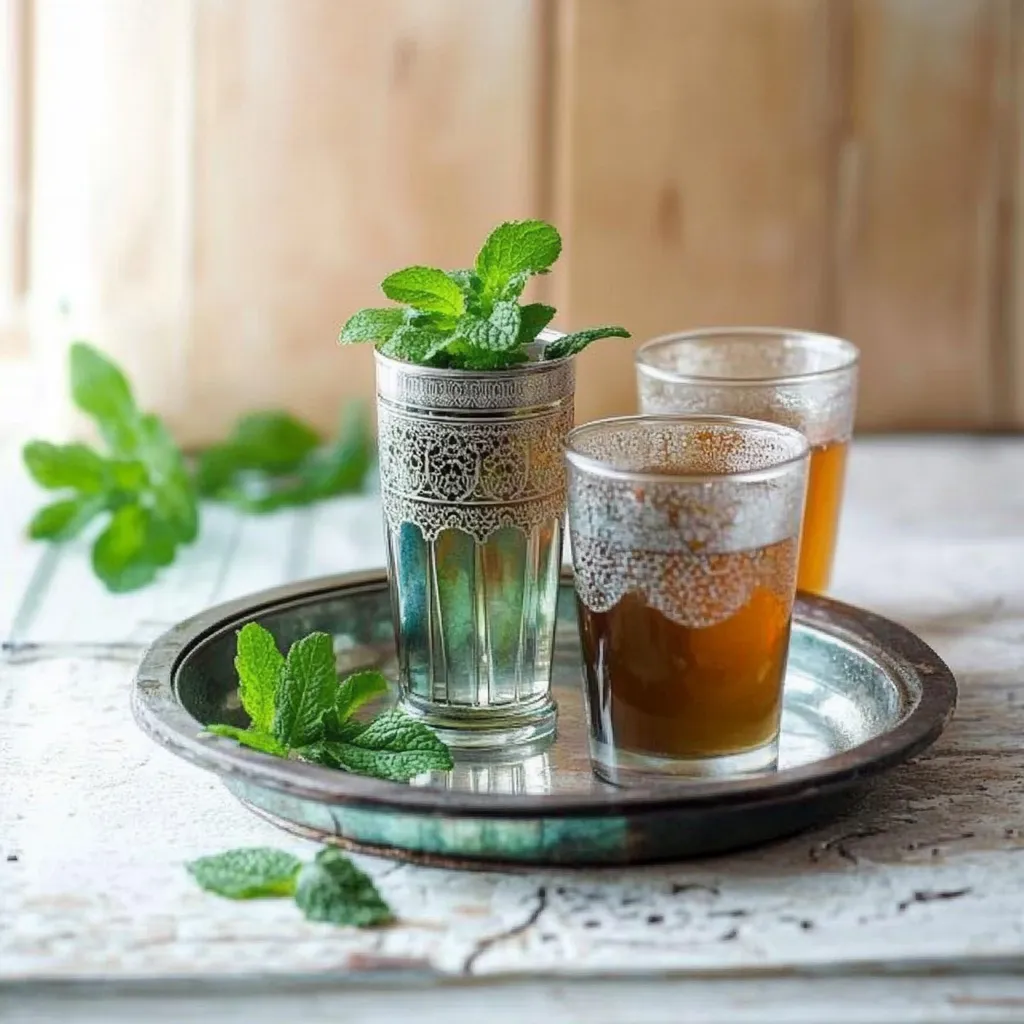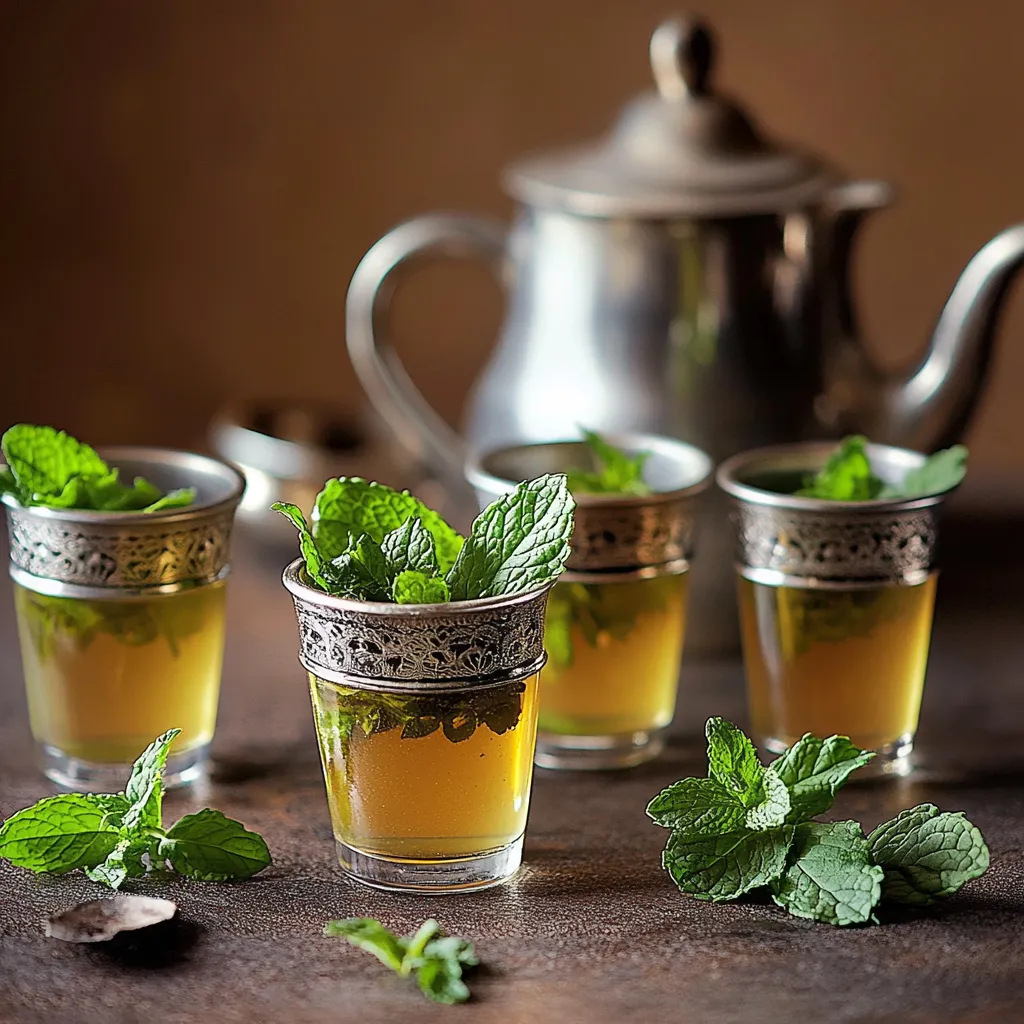 Bookmark
Bookmark
This aromatic Moroccan Mint Tea transports you straight to the bustling markets of Marrakech with its vibrant flavor and soothing properties. The traditional brewing method enhances the delicate balance between the robust gunpowder tea and fresh mint leaves.
I first learned to make this tea while visiting a Berber family in the Atlas Mountains. The ceremonial pouring from height was intimidating at first, but now it's my favorite party trick when hosting friends for Middle Eastern dinners.
Ingredients
- Gunpowder green tea leaves provides the strong base essential for authentic flavor. Look for tightly rolled pellets that unfurl beautifully.
- Fresh mint leaves the star ingredient that should be abundant and vibrant. Garden mint or spearmint work wonderfully.
- Boiling water temperature matters for proper extraction of flavors.
- Sugar traditionally Moroccans use generous amounts, but adjust to your taste preference. Look for large crystal sugar if possible.
Step-by-Step Instructions
- Warm the Teapot
- Pour a small amount of boiling water into your teapot, swirl it around thoroughly to heat the ceramic, then discard the water. This essential step ensures your tea maintains proper temperature throughout brewing.
- Rinse the Tea Leaves
- Add the gunpowder tea leaves to the warmed pot and pour approximately 100ml of boiling water over them. Gently swirl to wet all the leaves, then immediately pour out this liquid. This crucial step removes excess tannins that would otherwise make your tea bitter.
- Add Mint and Steep
- Place a generous handful of fresh mint leaves into the pot and pour the remaining boiling water over them. Allow this mixture to steep undisturbed for five minutes to extract the full aromatic profile of both the tea and mint.
- Prepare the Serving Cups
- While the tea steeps, place a few mint leaves or a small sprig in each empty cup. This adds visual appeal and releases additional aroma when the hot tea is poured.
- Pour with Flair
- For authentic presentation, pour the tea from height, starting close to the cup and gradually raising the teapot to create a light foam. This traditional technique aerates the tea and enhances both flavor and presentation.
 Bookmark
Bookmark
The gunpowder tea used in authentic Moroccan mint tea gets its name from its appearance rather than any explosive qualities. My Moroccan friend's grandmother taught me that the quality of the tea is judged by how many times the leaves can be reused while still producing flavorful results.
The Art of Moroccan Tea Service
Moroccan mint tea isn't just a beverage but a symbol of hospitality and friendship. Traditional service involves the host pouring the first cup, tasting it themselves to ensure quality, then pouring for guests. The ceremonial pouring from height creates a thin layer of foam called the "crown" which indicates proper preparation. When visiting homes in Morocco, refusing tea can be considered impolite as it represents the host's welcome.
Adjusting Sweetness Levels
While traditional Moroccan mint tea is famously sweet, modern preparations often reduce sugar amounts. Start with less sugar than you think you need as the mint provides natural sweetness. For an authentic experience, try dissolving sugar directly in the pot rather than adding it to individual cups. Some regions in Morocco place sugar cubes directly in the serving glasses rather than dissolving in the pot, allowing guests to control sweetness.
Seasonal Variations
Summer preparation often includes additional cooling herbs like lemon verbena, orange blossoms, or even a touch of absinthe leaf for complexity. Winter versions might incorporate warming spices like cinnamon sticks, star anise, or cardamom pods added during steeping. During Ramadan, Moroccan families often prepare special blends with added sage or wormwood to aid digestion after breaking fast.
Health Benefits
Mint tea is traditionally served after meals in Morocco because it aids digestion and freshens breath. The combination of green tea and mint provides dual benefits. The green tea contains catechins that support metabolism while mint soothes the digestive tract and reduces bloating.
Recipe FAQs
- → Why do you rinse the tea leaves first?
Rinsing the gunpowder green tea leaves removes excess tannins that can make the tea bitter. This brief first steep is discarded, allowing the second brew to have a smoother, more balanced flavor that complements the mint perfectly.
- → Why pour the tea from a height?
Pouring from a height is a traditional Moroccan technique that aerates the tea, creating a light foam on top. This process, called 'atay,' enhances the flavor and aroma while also cooling the tea slightly for immediate enjoyment.
- → How much sugar should I add?
Traditional Moroccan mint tea is quite sweet. While you can adjust to taste, authentic preparation typically uses 2-3 teaspoons of sugar per cup. Some Moroccans say it should be 'sweet as love' - which means quite sweet!
- → Can I use different types of mint?
While spearmint (Mentha spicata) is the traditional choice in Morocco, you can experiment with other varieties like peppermint or chocolate mint. Each will impart a slightly different flavor profile to your tea.
- → What is gunpowder green tea?
Gunpowder green tea is a specific type of Chinese tea where the leaves are rolled into small pellets resembling gunpowder. This rolling helps preserve flavor and freshness, making it ideal for Moroccan mint tea. The leaves unfurl dramatically when steeped.
- → When is Moroccan mint tea typically served?
In Morocco, mint tea is served throughout the day, but especially with meals, for guests, or during social gatherings. It's considered an essential part of hospitality and is often served three times to guests - the first cup is said to be 'as gentle as life,' the second 'as strong as love,' and the third 'as bitter as death.'
